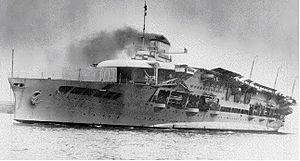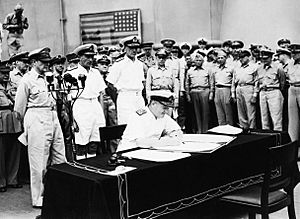Bruce Fraser, 1st Baron Fraser of North Cape facts for kids
Quick facts for kids
The Lord Fraser of North Cape
|
|
|---|---|
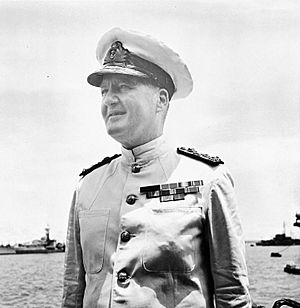
Admiral Sir Bruce Fraser on board HMS Duke of York at Guam
|
|
| Born | 5 February 1888 Acton, England |
| Died | 12 February 1981 (aged 93) London, England |
| Allegiance | United Kingdom |
| Service/ |
Royal Navy |
| Years of service | 1904–1951 |
| Rank | Admiral of the Fleet |
| Commands held | First Sea Lord (1948–51) Commander-in-Chief, Portsmouth (1947–48) British Pacific Fleet (1944–45) Eastern Fleet (1944) Home Fleet (1943–44) 2nd Battle Squadron (1942–43) HMS Glorious (1936–37) HMS Effingham (1929–32) |
| Battles/wars | |
| Awards | Knight Grand Cross of the Order of the Bath Knight Commander of the Order of the British Empire Grand Officer of the Order of Orange-Nassau (Netherlands) Order of Suvorov (Soviet Union) Legion d'Honneur (France) Croix de Guerre (France) Grand Cross of the Order of St. Olav (Norway) Grand Cross of the Order of the Dannebrog (Denmark) Navy Distinguished Service Medal (United States) |
| Relations | General Alexander Fraser (father) |
Admiral of the Fleet Bruce Austin Fraser, 1st Baron Fraser of North Cape (born 5 February 1888 – died 12 February 1981) was a very important officer in the Royal Navy. He fought in the First World War and helped with the Gallipoli Campaign. He also took part in the internment (holding) of the German High Seas Fleet after the war.
During the Second World War, he first helped manage the navy's equipment. Later, he became a top commander of the Home Fleet. He led the ships that destroyed the powerful German battleship German battleship German battleship Scharnhorst. After the war, he became the First Sea Lord, the head of the Royal Navy. In this role, he helped create NATO, a military alliance.
Contents
Bruce Fraser was born in Acton, England. His father was General Alexander Fraser. Bruce went to Bradfield College before joining the Royal Navy in 1902. He started as a cadet on the training ship HMS Britannia.
In 1904, he became a midshipman on the battleship HMS Hannibal. He then served on other ships like HMS Prince George and HMS Triumph. By 1908, he was a lieutenant on the cruiser HMS Lancaster.
In 1910, Fraser joined the Home Fleet. He later went to HMS Excellent, which was the Royal Navy's gunnery school. Here, he trained to become a specialist in naval gunnery.
First World War Service
During the First World War, Fraser served on the cruiser HMS Minerva. This ship helped support soldiers on land during the Gallipoli Campaign. It also carried troops to protect Egypt.
In 1916, he became the Gunnery Officer on the battleship HMS Resolution. He spent the rest of the war with the Grand Fleet. After the war ended in 1918, he helped with the internment of the German High Seas Fleet. This meant taking control of the German ships.
Between the Wars
After the war, Fraser was promoted to commander in 1919. He volunteered to serve with a Russian fleet in the Caspian Sea. However, he was captured and held prisoner by Bolsheviks in Azerbaijan. He was released in November 1920.
He then worked at the Admiralty, which was the navy's headquarters. He became the Fleet Gunnery Officer for the Mediterranean Fleet. In 1926, he was promoted to captain.
From 1929 to 1932, he commanded the cruiser HMS Effingham. Later, he became the Director of the Naval Ordnance Department at the Admiralty.
In 1936, Fraser took command of the aircraft carrier HMS Glorious. He was promoted to rear admiral in 1938. He then became the Chief of Staff for the Commander-in-Chief of the Mediterranean Fleet.
Second World War
Just before the Second World War began in 1939, Fraser was put in charge of naval equipment as the Third Sea Lord and Controller of the Navy. He was promoted to vice admiral in 1940.
In 1942, he became the second-in-command of the Home Fleet. This was a very important group of ships in the Royal Navy.
Battle of North Cape
In May 1943, Fraser became the Commander-in-Chief of the Home Fleet. In this role, he led the Royal Navy forces that destroyed the German battleship Scharnhorst. This happened at the Battle of the North Cape on 26 December 1943.
The Home Fleet often protected convoys (groups of supply ships) going to Murmansk in the Soviet Union. Fraser believed that the Scharnhorst would try to attack one of these convoys. So, he sailed his flagship, HMS Duke of York, to a position where he could intercept the German ship.
The Scharnhorst was hit many times by Duke of York and other ships. A 14-inch shell hit its boiler room, which slowed it down. This made it unable to escape. It was then hit by torpedoes and sank that night. This victory was very important for the Allies. It also avenged the sinking of his old ship, HMS Glorious, by Scharnhorst three years earlier.
For this important victory, Fraser received high honors from both Britain and Russia.
Pacific Fleet Commander
In February 1944, Fraser was promoted to full admiral. He took command of the Eastern Fleet in August 1944. Then, in December 1944, he became the commander of the British Pacific Fleet.
He led the fleet from his headquarters in Sydney, Australia. He worked closely with the United States Navy. This helped the two navies work together smoothly.
Admiral Fraser was the British officer who signed the Japanese Instrument of Surrender in Tokyo Bay on 2 September 1945. This officially ended the Second World War.
Later Career and Legacy
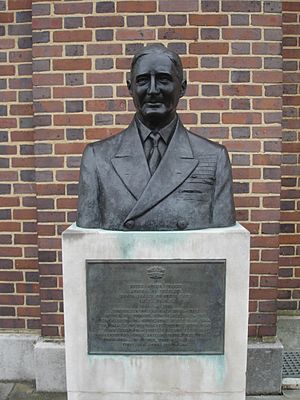
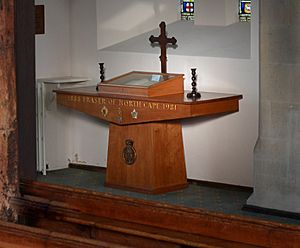
In 1946, Bruce Fraser was made a Baron, becoming Baron Fraser of North Cape. This is a special title given by the King.
In 1947, he became the Commander-in-Chief of Portsmouth. Then, in 1948, he was promoted to Admiral of the Fleet. This is the highest rank in the Royal Navy. He also became the First Sea Lord and Chief of the Naval Staff, the head of the entire Royal Navy.
As First Sea Lord, he helped create NATO (North Atlantic Treaty Organization). This was a military alliance formed to protect Western countries. He agreed that the main commander for the Atlantic should be an American admiral, even though some British leaders disagreed.
Admiral Fraser retired in December 1951. He passed away in London on 12 February 1981, at the age of 93. He never married, so his title ended with him.
|


